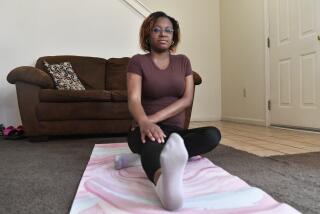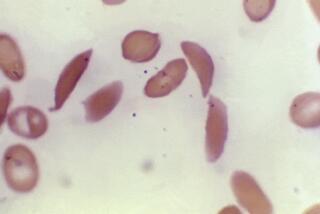With a deft snip, potential treatment emerges for deadly childhood Duchenne Muscular Dystrophy
- Share via
Using cells from patients with Duchenne Muscular Dystrophy, a genetic disease that affects one in 5,000 boys, UCLA scientists have devised a strategy for creating “corrected” stem cells that could restore tissue under attack by the deadly muscle-wasting disorder.
A gene-editing procedure described by researchers Thursday in the journal Cell Stem Cell resulted in a gene that functions properly, coding for the production of proteins called dystrophins, which are deficient in people with Duchenne Muscular Dystrophy (DMD). It could lead to one of the first therapeutic uses of a controversial new gene-editing technique known as CRISPR/Cas9.
This feat of genetic surgery is a key step in the development of a therapy that could treat DMD.
The leading childhood form of muscular dystrophy, DMD progressively destroys the musculature of affected boys and typically leads to death in their mid-20s. In patients with DMD, a genetic defect disrupts the production of dystrophins, which are essential for the growth, protection and normal function of heart and skeletal muscle.
The research effort drew together geneticists, stem cell scientists and DMD experts, and used the CRISPR/Cas9 gene-editing technique, which promises to accelerate genetic therapies by making the alteration of genes more precise and efficient.
Working together, scientists from UCLA’s Broad Center for Regenerative Medicine and Stem Cell Research and its Center for Duchenne Muscular Dystrophy focused on the largest known human gene, where the DNA sequences implicated in DMD are nestled in among many others.
Taking a skin cell from a Duchenne patient, they first reprogrammed that “fibroblast” to revert to a primitive stem-cell form. They located a long stretch of that gene that appeared to produce the dystrophin defect, and used “guide DNA” — tiny homing mechanisms — to snip away the offending sequence at either end. Finally, they spliced the altered gene back together.
By this method, the team had engineered a stem cell capable of giving rise to skeletal muscle or heart tissue with dystrophin production that is nearly normal. If it could be reintroduced into the Duchenne patient from which the original stem cell came, it should be a perfect fit — and potentially powerful therapy.
NEWSLETTER: Get the day’s top headlines from Times Editor Davan Maharaj >>
“We knew it was a large region of the gene to delete,” said study co-author Courtney Young, a graduate student at UCLA’s molecular biology institute. “To cut in two places at the same time and get them to join together: we weren’t even sure it would work.”
The editing trick was akin to making a dining room table with elaborately turned legs into a functional coffee table: Young had to find a way to cut out a piece of each leg and splice the remaining ends together so they lined up perfectly. When the team tested the edited stem cell, they could see that it would function normally.
For Young, it was more than a scientific victory. She has a 9-year-old cousin with DMD. That she could help him or others with the disease, she said, “makes it more meaningful.”
The next step, said study co-author April Pyle, a stem cell biologist and lab director at the Broad Center, will be to “cut out the middleman” and perform the editing technique on stem cells derived directly from patients’ muscles.
That is just one of many steps that must be taken before this gene-editing procedure could be used to help patients with DMD. As in other potential uses of CRISPR/Cas9 gene-editing, researchers will have to ensure they have not inadvertently added or snipped out genetic sequences with unanticipated “off-target” effects. And they still must find efficient ways to introduce cells with the edited DNA into patients so that those “corrected” cells can establish themselves and restore muscle function.
If all those steps come together, said co-author Melissa Spencer, “this kind of therapy would be a permanent correction.” Because these cells effectively clone themselves, “you don’t need to fix every stem cell” to overcome the debilitating effects of a genetic disorder.
“You could have, not a cure, but a very, very effective therapy for a large number of patients.”
Follow me on Twitter @LATMelissaHealy and “like” Los Angeles Times Science & Health on Facebook.
ALSO:
Belief in all-knowing, punitive gods aided the growth of human societies, study says
‘We can hear the universe’: Scientists detect gravitational waves, predicted by Einstein
In war-torn Afghanistan, astronomer sees hope and promise in the study of the heavens







